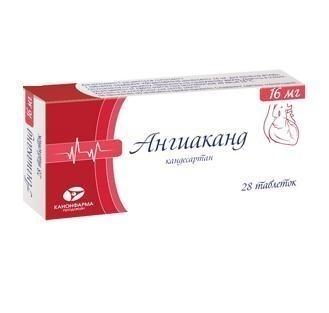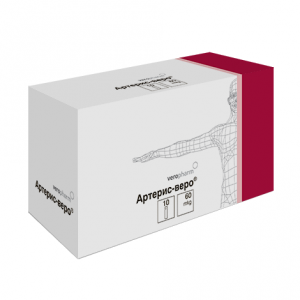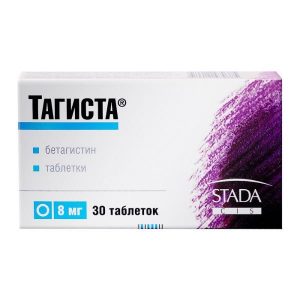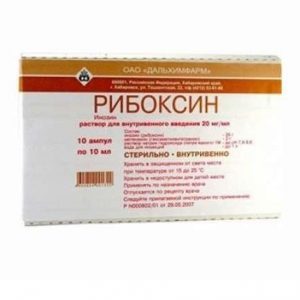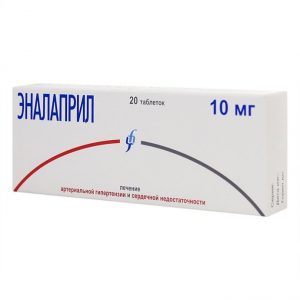Description
Release form
Tablets.
Packing
28 pcs.
Pharmacological action of
Angiakand has a vasodilating, hypotensive, diuretic effect.
Indications
– Arterial hypertension.
– Chronic heart failure and impaired systolic function of the left ventricle (decrease in the ejection fraction of the left ventricle of less than 40%) as an adjunct therapy to angiotensin converting enzyme (ACE) inhibitors or intolerance to ACE inhibitors.
Contraindications
hypersensitivity to candesartan or other components Angiakand
lactase deficiency, lactose intolerance, glucose-galactose malabsorption
primary hyperaldosteronism srdl srld function .
Caution: severe renal failure (Cl creatinine less than 30 ml / min) bilateral renal artery stenosis of a single kidney renal artery stenosis after a kidney transplant in a history of hemodynamically significant stenosis of the aortic and mitral valve cerebrovascular disease coronary heart disease hypertrophic obstructive cardiomyopathy decrease in OCC hyperkali.
Use in pregnancy and lactation
Animal studies have shown kidney damage in the embryonic and neonatal periods when using candesartan. The damage mechanism is believed to be due to the pharmacological effects of the drug on RAAS.
In a human embryo, the blood supply system of the kidney, which depends on the development of RAAS, begins to form in the second trimester of pregnancy. Thus, the risk to the fetus increases with the use of candesartan in the II and III trimesters of pregnancy. Drugs having a direct effect on RAAS, can cause impaired fetal development or have a negative effect on the newborn, including death, when used in the II and III trimesters of pregnancy.
Angiakand should not be used during pregnancy. If pregnancy is detected during the period of treatment with the drug, therapy should be stopped as soon as possible.
It is not known whether candesartan is excreted in breast milk. Due to the possible undesirable effect on infants, Angiakand should not be used during lactation.
Composition
1 tablet contains:
active substance:
candesartan cilexetil 16 mg
excipients:
pregelatinized corn starch – 23.8 mg,
croscarmellose sodium (primrose) – 5 mg sucrose (5 mg sucrose) mg,
magnesium stearate – 1 mg,
povidone-K30 – 4.2 mg.
Dosage and administration
Inside, regardless of food intake, 1 time per day.
Arterial hypertension. The recommended starting and maintenance dose is 8 mg once daily. Patients who require a further decrease in blood pressure are recommended to increase the dose to 16 mg once a day. The maximum daily dose of the drug is 32 mg 1 time per day.
The maximum antihypertensive effect occurs 4 weeks after the start of treatment.
If therapy with Angiakand does not reduce blood pressure to the optimal target level, it is recommended to add a thiazide diuretic to therapy.
In elderly patients, initial dose adjustment is not required.
In patients with mild or moderate impaired renal function (Cl creatinine> 30 ml / min), an initial dose change is not required.
Patients with severe renal impairment (creatinine Cl Chronic heart failure. Recommended starting dose is 4 mg 1 time per day (candesartan may be used in another form of release).
Increasing the dose to 32 mg once a day or to the maximum tolerated dose is carried out by doubling it with an interval of at least 2 weeks.
Elderly patients and patients with impaired renal and / or liver function do not need to change the initial dose of the drug.
Side effects
Arterial hypertension, the most common side effects ( 1/100,
From the central nervous system: dizziness, weakness, headache.
From the musculoskeletal system, connective tissue: back pain.
Other: respiratory infection.
Laboratory parameters: hemoglobin decrease, hypercreatininemia, increased blood urea concentration, hyperkalemia, hyponatremia, increased ALT activity.
Chronic heart failure, the most common side effects ( 1/100,
From the CCC: marked decrease in blood pressure.
From the urinary system: impaired renal function.
Laboratory changes: hypercreatininemia, increased concentration of urea in the blood, hyperkalemia.
During the post-marketing use of candesartan, the following side effects were reported (frequency – less than 1/10000)
From the hemopoietic organs: leukopenia, neutropenia and agranulocytosis.
Laboratory parameters: hyperka iemiya, hyponatremia
CNS:. dizziness, weakness, headache
From the digestive system:. nausea.
From the liver and biliary tract: increased activity of hepatic transaminases, impaired liver function or hepatitis.
Allergic reactions: angioedema, skin rash, itching, urticaria.
From the musculoskeletal system, connective tissue: back pain, arthralgia, myalgia.
From the urinary system: impaired renal function, including acute renal failure in susceptible patients.
From the respiratory system: cough.
Drug Interaction
When combined with candesartan with hydrochlorothiazide, warfarin, digoxin, oral contraceptives (ethinylestradiol / levonorgestrel), glibenclamide, nifedipine and enalapriamine.
Reversible increases in serum lithium concentrations and the development of toxic reactions have been reported with the concomitant use of lithium with ACE inhibitors. Adverse reactions may also occur with the use of angiotensin II receptor antagonists, and it is therefore recommended to control serum lithium levels when combined with these drugs.
When co-administered with angiotensin II receptor antagonists and NSAIDs, including selective COX-2 inhibitors and non-selective NSAIDs (eg, acetylsalicylic acid at a dose greater than 3 g / day), the hypotensive effect of candesartan may be reduced. As with ACE inhibitors, the concomitant use of angiotensin II receptor antagonists and NSAIDs increases the risk of renal impairment up to the development of renal failure, leading to hyperkalemia in patients with impaired renal function. This combination should be used with caution, especially in elderly patients. All patients should receive sufficient fluid. It is necessary to monitor kidney function at the beginning of therapy and thereafter.
Medicines affecting RAAS, may increase the concentration of urea and creatinine in the blood in patients with bilateral renal artery stenosis or single renal artery stenosis.
Diuretics and other antihypertensives increase the risk of arterial hypotension.
Potassium-sparing diuretics, potassium preparations, potassium-containing salt substitutes, and other drugs that may increase serum potassium (eg heparin) increase the risk of hyperkalemia.
Candesartan is poorly metabolised in the liver (CYP2C9 isoenzyme). Interaction studies did not reveal the effect of candesartan on CYP2C9 and CYP3A4 isoenzymes. The effect on other isoenzymes of the cytochrome P450 system has not been studied.
Overdose
Symptoms: severe BP, dizziness, tachycardia.
Treatment: symptomatic. Put the patient on his back, raise his lower extremities above head level, increase BCC if necessary by infusion of 0.9% sodium chloride solution, appoint sympathomimetics. Hemodialysis is ineffective.
Storage conditions
In a dry, dark place at a temperature of no higher than 25 ° C.
Expiration
2 years.
Deystvuyuschee substances
candesartan
pharmacy terms and conditions
Kanonfarma, Russia
